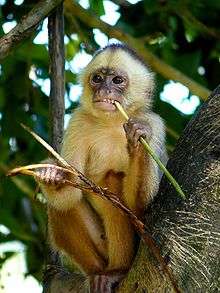Cebidae
| Cebidae[1][2] Temporal range: Late Oligocene to present | |
|---|---|
 | |
| White-headed capuchin (Cebus capucinus) | |
| Scientific classification | |
| Kingdom: | Animalia |
| Phylum: | Chordata |
| Class: | Mammalia |
| Order: | Primates |
| Suborder: | Haplorhini |
| Infraorder: | Simiiformes |
| Parvorder: | Platyrrhini |
| Family: | Cebidae Bonaparte, 1831 |
| Type genus | |
| Cebus | |
| Genera | |
The Cebidae are one of the five families of New World monkeys now recognised. It includes the capuchin monkeys and squirrel monkeys.[2] These species are found throughout tropical and subtropical South and Central America.
Characteristics
Cebid monkeys are arboreal animals that only rarely travel on the ground. They are generally small monkeys, ranging in size up to that of the brown capuchin, with a body length of 33 to 56 cm, and a weight of 2.5 to 3.9 kilograms. They are somewhat variable in form and coloration, but all have the wide, flat, noses typical of New World monkeys. They are different from marmosets as they have additional molar tooth and a prehensile tail.[3]
They are omnivorous, mostly eating fruit and insects, although the proportions of these foods vary greatly between species. They have the dental formula:2.1.3.2-32.1.3.2-3
Females give birth to one or two young after a gestation period of between 130 and 170 days, depending on species. They are social animals, living in groups of between five and forty individuals, with the smaller species typically forming larger groups. They are generally diurnal in habit.[4]
Classification
Previously, New World monkeys were divided between Callitrichidae and this family. For a few recent years, marmosets, tamarins, and lion tamarins were placed as a subfamily (Callitrichinae) in Cebidae, while moving other genera from Cebidae into the families Aotidae, Pitheciidae and Atelidae.[1] The most recent classification of New World monkeys again splits the callitrichids off, leaving only the capuchins and squirrel monkeys in this family.[2]
- Family Cebidae: capuchins and squirrel monkeys
 White-fronted capuchin (Cebus albifrons)
White-fronted capuchin (Cebus albifrons)- Subfamily Cebinae
- Genus Cebus
- Kaapori capuchin, Cebus kaapori
- Wedge-capped capuchin, Cebus olivaceus
- White-headed capuchin, Cebus capucinus
- White-fronted capuchin, Cebus albifrons
- Genus Sapajus
- Black-striped capuchin, Sapajus libidinosus
- Black capuchin, Sapajus nigritus
- Blond capuchin, Sapajus flavius
- Golden-bellied capuchin, Sapajus xanthosternos
- Tufted capuchin, Sapajus apella
 Common squirrel monkey (Saimiri sciureus)
Common squirrel monkey (Saimiri sciureus)
- Genus Cebus
- Subfamily Saimiriinae
- Genus Saimiri
- Bare-eared squirrel monkey, Saimiri ustus
- Black squirrel monkey, Saimiri vanzolini
- Black-capped squirrel monkey, Saimiri boliviensis
- Central American squirrel monkey, Saimiri oerstedi
- Common squirrel monkey, Saimiri sciureus
- Genus Saimiri
- Subfamily Cebinae
Extinct taxa
- Subfamily Cebinae
- Genus Acrecebus
- Genus Dolichocebus
- Genus Chilecebus
- Genus Neosaimiri
- Neosaimiri fieldsi
- Genus Laventiana
References
| Wikispecies has information related to: Cebidae |
- 1 2 Groves, C.P. (2005). Wilson, D.E.; Reeder, D.M., eds. Mammal Species of the World: A Taxonomic and Geographic Reference (3rd ed.). Baltimore: Johns Hopkins University Press. pp. 129–139. OCLC 62265494. ISBN 0-801-88221-4.
- 1 2 3 Rylands AB, Mittermeier RA (2009). "The Diversity of the New World Primates (Platyrrhini)". In Garber PA, Estrada A, Bicca-Marques JC, Heymann EW, Strier KB. South American Primates: Comparative Perspectives in the Study of Behavior, Ecology, and Conservation. Springer. ISBN 978-0-387-78704-6.
- ↑ "77". Organic Evolution. New York: The Macmillan Company. 1921.
- ↑ Janson, C.H.; Rylands, A.B. (1984). Macdonald, D., ed. The Encyclopedia of Mammals. New York: Facts on File. pp. 342–361. ISBN 0-87196-871-1.